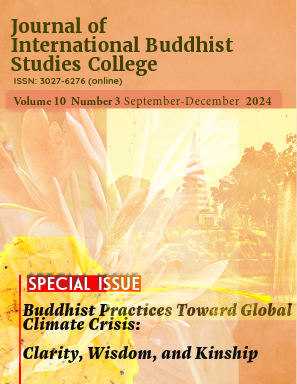The Practical Application of Three Phases (Tiparivaṭṭa) and Twelve Aspects (Dvādasākāra) in Understanding the Four Noble Truths
Main Article Content
Abstract
This research mainly aimed to (1) explain the Four Noble Truths as the core of Buddha's teachings, (2) study the concept of Dukkha and Nirodha in Buddhism, and (3) explain the practical application of the Three Phases (tiparivaṭṭa) and Twelve Aspects (dvādasākāra) in understanding the Four Noble Truths. It is a qualitative research methodology with a library approach, which collects data from primary and secondary sources. The Pali Canon, which contains the original teaching of the Buddha, and commentaries which contain further explanations given by Elders, are considered the primary sources. The secondary sources include articles, journals, and books written by temporary scholars. With this approach, the relevant data are gathered, examined and concluded.
This research shows that the Four Noble Truths are the core of the Buddha's teaching. The Noble Truths structure the entire teaching of the Buddha, containing its many other principles just as the elephant's footprint includes the footprints of all other animals. The Noble Truths is a teaching unique to the Buddhas (Buddhānaṃ sāmukkaṃsikā dhammadesanā). It deals with the four truths, namely the truth of suffering (dukkha), the origin of suffering (dukkhasamudaya), the cessation of suffering (dukkhanirodha) and the path leading to the cessation of suffering (dukkhanirodhagāminīpaṭipadā). It shows that the concept of Dukkha and Nirodha in Buddhism is unique. Possessing knowledge about the Four Noble Truths is called Right View (sammādiṭṭhi), the first factor of the Eightfold Noble Path explained by the Buddha as the path leading to the cessation of suffering. However, mere acquittance with these truths, devoid of corresponding actions, proves insufficient for achieving ultimate liberation. The concept of Three Phases (tiparivaṭṭa) and Twelve Aspects (dvādasākāra) is presented to explain the Four Noble Truths and to guide the followers about the proper response should be adopted.
Article Details
The Journal of TCI is licensed under a Creative Commons Attribution-NonCommercial-NoDerivatives 4.0 International (CC BY-NC-ND 4.0) licence unless otherwise stated. Please read our Policies page for more information on Open Access, copyright and permissions.
References
Bhikkhu Bodhi. (2000). The Connected Discourses of the Buddha: A New Translation of the Saṃyutta Nikāya. Wisdom Publications.
Bhikkhu Bodhi. (2010). The Noble Eightfold Path: The Way to the End of Suffering. Wisdom Publications.
Bhikkhu Bodhi. (2005). In the Buddha’s Words: An Anthology of Discourses from the Pali Canon. Wisdom Publications.
Buddhaghosa. (1991). The Path of Purification (Visuddhimagga). Buddhist Publication Society.
Gethin, R. (1998). The Foundations of Buddhism. Oxford University Press.
Gunaratna, V. F. (2010). The significance of Four Noble Truths. Journal of Buddhist Studies, 3(2), 204-207.
Hamzah, Amir. (2019). Metode Penelitian Kepustakaan. Literasi Nusantara.
Kabat-Zinn, J. (1990). Full Catastrophe Living: Using the Wisdom of Your Body and Mind to Face Stress, Pain, and Ilness. Delta.
Nanayakkara, S. (2013). Theravada Buddhism: Basics of Doctrine, Ethics and Social Philosophy. Sarasavi..
Nanayakkara, S. (2016). Buddhist Philosophy, History, and Culture - Selected Essays of Sanath Nanayakkara. S. Godage & Brothers (Pvt) Ltd.
Nyanatiloka. (2011). The Word of the Buddha: An Outline of the Teachings of the Buddha in the Words of the Pāli Canon. Buddhist Publication Society.
Rahula, W. (2006). What the Buddha Taught. Grove Press.
Suzuki, D. T. (2014). An Introduction to Zen Buddhism. Grove Press.
Zed, M. (2014). Metode Penelitian Kepustakaan. Yayasan Pustaka Obor Indonesia.


